Welcome to my Maker Monday series, where I chronicle adventures in problem solving, building things, and doing off-beat industrial art projects. You can read the first installment here. This is an image-heavy post and exceeds the capacity of certain email providers. To get the full effect, read this post on the web at http://jdanielsawyer.substack.com
Consider the bane of the Internet: the “Well actually…” guy. The fellow who can’t resist harshing everyone’s mellow just to show off how smart he is while demonstrating his relative cluelessness about things like context, social cues, humor, and fun.
Thus, it is with a full understanding of the irony involved that I’m about to make the ultimate case for the utility of doing a version of “Well, actually…” in your own head, and it has everything to do with how memes (and, indeed, humor) work.
The Joke is On Us
Why do we laugh at jokes?
Jokes turn on linguistic inversions, little surprises, horrific ideas, and uncomfortable truths.
So why do we laugh at them?
Isn’t taking pleasure in humor essentially taking pleasure in the horribleness of life?
Well, actually….yes. But it’s more than that.
The jokes we share with one another are meant to build and reinforce social bonds and group solidarity. If you laugh at the same jokes as me, and/or find the same parts of life as amusingly ironic and/or perplexing as I do, then you’re my kinda people. The fact that those assholes over there don’t get the damn joke is proof of their benighted dipshittery.
These jokes also (though we hate to admit it) reveal our own benighted dipshittery to others who are more in the know than we are on the point at issue.
I’m a novelist. My life’s work essentially boils down to “learning stuff in order to create theatrical performances exploring ‘theory of mind.’” One of the weird things I’ve run into repeatedly in my endeavors is that the kinds of questions we ask in exasperation (or rhetorically as gotchas) often do have answers, and those answers often open the doors to entirely new knowledge landscapes.
So, in the spirit of enabling the apotheosis of the healthy variety of the “Well, actually…” impulse, I’m going to pick on a Reddit meme that’s been making the rounds that unintentionally provides a view on the unexpected depths of the Maker universe.
Only a weirdo would own thirty hammers, right? So only a psycho would own thirty guns or more. Why on earth would any non-specialist ever need more than one or two hammers—and, by extension, one or two of any big meaty tool?
A Bag of Hammers
Let’s get one thing out of the way first. I have documented my use of hammers on this Substack before. I’m sure I’ll be doing it again. I mean, I do live in the middle of nowhere, and without the ability to pound a nail, I’d be screwed.
Which is, in fact, how I built this building when I didn’t have a hammer handy (because it was still packed up in storage):

That is what it looks like when a building is completely screwed.
Pounding it Out
But back to the main subject.
Not to get all philosophical on you, but consider, really, what is a hammer?
What makes a hammer a hammer? What essential hammeriness must be present for you to be sure you’ve got a hammer, and not something else?
A hammer is a weighted lever which transfers and focuses force from your hand. If it’s got a weight at one end, and your hand at another, and it works by turning the force of your swinging arm into a focused point-impact, it’s a hammer of some sort. Its job is not just to drive nails, its job is to move things.
My homesteading partner and I are currently seeking gigs for editorial, layout/design, voice over, audiobook narration, and strategic consulting work. Additionally, if you’re looking for a tutor for a student struggling with history, English, creative writing, or psychology, I’m available for hire.
Or you can help out substantially by joining me here as a paid subscriber.
The Claw
And oh brother, there are SO MANY SORTS OF HAMMERS. Everyone and their brother has some kind of hammer made especially for doing their pet thing, whether it’s pounding nails or thwarting Mario.
That particular brother is sporting the kind of hammer that probably pops to mind when you think of the word “hammer.”
Behold, the common claw hammer. This one has a fiberglass handle with a padded rubber grip to keep your hand comfortable while knocking holes in the drywall around the nail you’re trying to sink. It’s got a flat face at one end for bruising thumbs, and a split claw on the back for chewing up wood.
That part always looked like a sweeping hairdo to me. It’s the mullet of hammers—business in the front, party in the back.
When used properly rather than as an orthopedist’s customer-generation tool, the flat face is struck against the head of a nail to drive that nail into a piece of wood. The claw in the back is for pulling nails out after you’ve bent them by hitting them cock-eyed with that itty bitty striking surface.1
Everyone needs a claw hammer in their home maintenance kit. It’s a good all around tool for hanging picture frames, lifting up furniture or appliances so you can rescue your keys (substitute crow-bar), bashing down walls as you madly hunt down the mouse that stole your last peanut-butter covered Ritz,2 defending yourself against home invaders, and tapping wrenches to break stubborn bolts loose when you’re working on your car. Demolition, deconstruction, construction, plumbing, auto repair, leverage, weapon—the claw hammer brings it all. It’s such a versatile tool and such a potent symbol of tools and the power they give humanity that George Stewart made the possession of a claw hammer a major thematic point in his classic post-apocalyptic novel, Earth Abides.
And, of course, they come in all sizes for all uses.
These are my claw hammers—or, at least, the ones that live in the shop. There are three more on site: one in each car, and one in the ag building (where the chicken feed and tools live) for doing repairs to the chicken coop.3 Here’s the fun part—the slight variations in size and handle type/ergonomics mean that I when I need a claw hammer, I don’t need just any claw hammer, I need a specific claw hammer.
The Roofer
So claw hammers are what spring to mind when someone uses the word “hammer,” even when you’re properly hammered,4 but they’re not the whole story where hammers are concerned. The variety of hammers on offer is, to put it mildly, striking.
These are roofing hammers. The hatchet-end is used for cutting shingles to shape and also for prying up the edges of errant shingles. The hammer-face is used for driving nails through shingles, and the notch in the blade on the leftmost hammer is for pulling nails. You can also, in a pinch, use them to split wood (and cut shake shingles).5
During a couple summers in my youth, I worked as a roofer, and I discovered the startling utility of these critters. My partner, who insisted on using a knife and a framing hammer, was never able to move as fast as I did, either on shakes or on composite shingles. It’s a goofy-looking design, but it works, and works well. Turns out they also come in handy around the homestead—they’re an excellent hammer to carry when deconstructing the junk left on the land by the previous owner, because they’re essentially two tools in one.
These are two of the three roofing hammers I own—ironically, these aren’t the hammers I used on the job. I inherited both of these from relatives in the last couple years. The one I used when I was a roofer is still in storage.
The Ball-Peen
To get back to hammers you’re more likely to have seen, don’t forget the classic ball-peen hammer:
This classic alum of children’s toolkits (because it doesn’t have the sharp edges of a claw hammer) will let you peen with your balls to your heart’s content.
I promise, that’s not an obscene activity. The “peen” of a hammer (well, any hammer but the claw hammer) is its back-face.
“Peening” is striking something to alter its shape. Ball-peens are so named for their hemispherical back-face. Like a claw-hammer, they have a flat front-face (though I have modified the one on the right to have a slight rounding on its “flat” face). They’re designed for working sheet metal. The use of ball-peen hammers of various sizes is how a metalworker creates a pitted texture on the surface of plate armor and ornamental pieces. Use one of these babies against sheet metal on a bean-bag anvil and you can curve thin sheets of metal into any shape: car body panels, gauntlets, parabolic mirrors, the sky’s the limit. If you’re working metal hot (i.e. blacksmithing) you can very efficiently use the ball-peen to create thin spots in your work piece.
These are the two ball-peens I use most often. I have three others that are much smaller, and good for shaping copper, brass, and small pieces.
And, of course, you can still drive nails and generally whack things with them.
Little Big Head
Taking a step up the size scale, we find a pair of three-pound hammers.
As you can guess from the burn marks and cracked handles, these two get a lot of use around fire. They’re my heavy-duty forging hammers.
On the left, we have a cross-peen hammer, so named because the peen is a cross-wise, rounded wedge. When you smash it against something soft (like hot metal), it pushes the material out in two directions, rather like what happens when you press a rolling pin down into a ball of dough. Blacksmiths (or wannabe blacksmiths like yours truly) use it to control the direction of metal spread when they’re shaping a work piece.
Variants which change the orientation of the peen include vertical peen hammers and diagonal peen hammers, and they exist primarily for ergonomic reasons. This is my big one, which I use in my forge. I have a couple jeweler’s cross-peens which I use for tapping small rusty nuts to loosen them up, and also for doing small error corrections in car body panels.6
On the right, we have a 3 pound sledge, which has two flat hexagonal faces. In addition to being great for delivering a lot of force to flatten out big chunks of scrap steel in the forge, it’s useful any time you need to deliver a big heavy blow one-handed (knocking seized hubs loose on trailers and cars, driving fence posts into the ground, and chiseling on stone). Kitty has been known to use it to drive splitting wedges through wood7 when she’s too tired to use the maul (don’t worry, that one’s coming up).
But these two have got nothing on their bigger brothers…
The Sledge
The granddaddy of all hand-held hammers is the sledge hammer, seen at right in this picture:
The sledge is a chunk of iron usually ranging from 8 to 20 lbs (the one on the right is a 12-pounder) and isn’t the kind of thing might expect to need unless you’re trying to smash big rocks, but it comes in hand surprisingly often. The long two-handed axe-like handle lets you get your whole body into the swing of things when you need to drive a large pile into the ground, demolish houses, shatter concrete, bash up stubborn tree stumps, and create rough lumber from fallen trees.8
On the left is the sledge’s more incisive cousin, the splitting maul. It’s a sledge hammer on one side, and an axe on another. As the name implies, its job is to split wood along the grain, and is particularly useful for wet wood or knotty wood that isn’t inclined to split just because you adorably tapped on its end grain with an axe.
The two often go together—when the maul gets stuck in the wood, its back face (which is soft, for this reason) makes a perfect striking surface for the big sledge—that’s right, it’s a floor wax and a dessert topping splitting wedge, axe, and sledge hammer all in one!
I have a few other big hammers that I didn’t take a picture of because they’re on a job site at the other end of the property. They are the picks and pick-axes, which are big pointy sledge hammers used for chipping through stone and breaking up tough soil. They’re currently helping to build a root cellar in the side of a stony outcrop.
Axes
The hammer is easily humanity’s oldest tool. Pick up a rock in your hand, use it to smash something, and you’ve got a hammer.
Humanity’s cleverest tool, though, was invented when Ape-bert Einstein thought “You know, if I could cut things with this rock, all the chicks would totally dig me.” He used another rock bash one end of his hand-hammer into a sharp wedge (creating the first chisel in the process), and then stood upon the nearest rocky promontory and shouted:
“Behold, ye Ents! I have created the axe! Let’s get ready to lumber!”
Okay, okay, it probably didn’t happen that way, but the invention of the hand-axe did change our ancestors’ access to the world and everything in it. It was a tool and a weapon, it could be used to fell trees and make kindling and skin carcasses and hunt game.
The designs have come a long way, but we still make them out of rocks (i.e. iron ore) and fit them with wooden handles. They still retain the stamp of their lowly origin.
An axe is just an edgy hammer. When it’s held in one hand, we call it a “hatchet,” but it’s still just an axe. Tomahawks, war axes, felling axes, splitting axes, bearded axes, etc. are all simply hammers where the back side has been drawn into a flat vertical peen and sharpened.
And yes, you can still use them to drive nails.
Rock and Slag
We don’t do it much any more as individuals because we have engines to do it for us, but shaping rock is deep in our evolutionary bones—and even those of us who live in the suburbs sometimes find we need to do it. Maybe you’re digging up a part of the back yard to make a garden but you’ve found a big rock, and you have to break it up to move it (sledge hammer time!). Maybe you’ve been out in the wilderness and you’ve found a few interesting nodules that you think might be geodes or opals or other semi-precious crystals. Maybe you’re an archaeologist or a paleontologist or a prospector trying to pull one kind of stone (fossils, pottery, bone, minerals) out of another (sandstone, granite, etc.). Or maybe you have a job or hobby that creates glass as a byproduct, and you need to get rid of it.
Fear not: there are hammers for these jobs, too.
Behold, the geologist’s hammer—also known as the “rock hammer”. The square flat face is good for fracturing rock, while the peen (a spike peen in this case, though they also come in cross-peen) is good for delivering targeted blows to chip away at stubborn rock or hard-packed dirt.
I picked this one up at a garage sale and use it for rock-hounding around the site here. It comes in handy in the forge, too, as the square face gives me different shaping options for metal than my normal forge hammers do. The spike is useful for texturing work.
And it also pinch-hits as a glass-breaker for its little brothers when I can’t find either of those around.
I talk a lot in this Substack about forging because, frankly, it’s fun and it’s my current newest hobby. But if you’re going to make or repair metal things, you get a lot farther a lot faster if you learn to weld.
Welding uses heat (usually in the form of electricity) to melt metal together using a filler—it’s basically hot-glue for adults. Because metals oxidize (i.e. rust) a lot faster when they’re hot, welders must somehow keep the oxygen in the air away from the metal. One of the methods for doing this involves burning mixtures of paper and sand as you melt the metal. This creates a cloud of smoke around the weld, and leaves behind a kind of glass called “slag.”
In this image you can see the slag peeling off the fresh weld, which happens with certain welding rods if you get your settings just right. For everything else, you need something to knock off the slag in order to finish the piece.
Enter the chipping hammer, or slag hammer.
The entire purpose of this thing is to break the glass left by a welding rod. I’ve got a pair of these things hanging on hooks around my welding bench—you get into weird positions when welding, and you get a real chip on your shoulder when you get all set up and only then notice that your slag hammer is out of reach.
Mallets
You can tell a mallet by its distinctive, flat, bulbous shape. A mallet is a persuader—it hits things that aren’t moving in the direction you’re wanting them to go. The flat face lets it deliver all its force in the same direction without deflecting, and the broadness of the face allows you to cover a lot of area.
Traditional building methods (timber framing, round-wood building, Japanese wood building, peg and wedge joinery) use wooden mallets to drive pegs and wedges through holes in order to pressure-fit wood. The broad face of the mallet ensures that the wood being worked on isn’t traumatized and scarred by the experience.
Rubber mallets (right) are lighter weight versions of lead mallets (center), and both are used regularly in automotive applications to install and remove parts with narrow tolerances. They can deliver a very measured amount of force without damaging the objects of their attention.
The wood mallet (left) is something blacksmiths use to fine-tune their work without risking marring the finished surface. It delivers enough force to push the hot metal one way or another, but it’s soft and combustible, so instead of dinging the work piece it just caves in and burns up. I made the one in the top picture of this section out of a chunk of willow and an old broken hickory hammer handle.
The dead-blow hammer is the mallet’s ponderous, plodding relative, because its head is filled with sand (or lead shot). The loose material in the head prevents the hammer from bouncing back upon impact, delivering all the force of the blow to the target.
Close cousins of the mallet are the machinists’s hammers—so called because they’re used to make fine adjustments to delicate pieces on a lathe or in a mill (i.e. machine tools). They also come in handy when working leather or making jewelry. Also called “Soft-faced hammers,” they’re for times when you need that delicate touch. The one on the left has faces made of silicone, while the one on the right is made of brass.
Counting Up the Hammer-Heads
All of this is to say nothing of my jackhammer, or the collection of hammer heads that I’ve amassed in order to create future specialized hammers, such as flatters, power hammers, handled swages and drifts, and…well, now we really are getting into rarefied territory.
For those of you keeping count, I’ve enumerated thirty-six specific hammers from my personal collection in this article.
So, per our meme at the beginning, I must be a pretty scary and obsessive dude if I own that many hammers.
But here’s the thing:
I use them all. And I don’t have all the ones I need just to do the jobs I’m doing around here every day. And, despite the fact that I’m on a mountain top in the middle of nowhere, nothing that I do (aside from the blacksmithing) is all that different than what a normal weekend-warrior homeowner has call to do from time to time:
Fix cars, repair walls, hang pictures, split wood for kindling, limb trees, smooth out dents, drive nails, sink stakes in the ground, dig holes, and mend fences.
In other words, if we subtract out the hammers that such a person wouldn’t have a use for, we still wind up with around thirty hammers…and I’m a piker where hammers are concerned. Walk into any mechanic’s garage, machine shop, armorer’s shop, smithee, or woodworking shop, and you’re likely to find more hammers than these just devoted to that one discipline. My hammer collection is truly inadequate to the work I put it to, but I get along just like anyone else.
Here’s the fun part:
Out of all of these, I only bought three of them new. All of the others were garage-sale or salvage finds. Many of them didn’t have handles when I found them. Two of the great joys of being a maker is making the tools you use to make other things, and turning other people’s trash into some kind of treasure (whether for your own use or to pass on to someone else).
But, to zoom out to the broader point:
Upon close inspection, the meme that I started off with does reveal something important about the nature of the universe. What is true of hammers is true of all tools, and the deeper you get into any discipline or hobby, the more specialized tools you acquire. That’s true whether you’re a seamstress, a knitter, a leather crafter, a lineman, an electrician, a farrier, a costumer, a trap shooter, a hunter, a mechanic, or a knife-maker.
The incredulity and fear regarding guns that comes through in the meme is something that all of us experience, to some degree, when encountering a phenomenon which looks simple at first glance, but harbors terrifying complexity beneath the surface. I’ve written a book about the different sorts of guns and the functions they’re designed to serve. I’ve now written an article of the same sort about hammers. I own books of similar (or greater) depth about rope, pulleys, wheels, fire, bearings, torches, and (believe it or not) one on mud and another on crap (literally).
Any time you find yourself looking at a dizzying pile of tradesman’s tools thinking “this is way overboard,” it’s a good time to stop and consider that they might know something about the world that you don’t, and you’ve just gotten a chance to see a corner of reality that you never imagined existed.
If you’re looking for fresh stories, you can find my novels, short stories, visions, and dreams (along with some how-to books and literary studies) by clicking here.
When not haunting your Substack client, I write novels, literary studies, and how-to books. If you’re feeling adventurous click here to find a ridiculous number of fiction and nonfiction podcasts for which I will eventually have to accept responsibility.
This column is a big part of how I make my living—bigger now due to recent exciting events which you can read about here. Because of this, I’m offering a 20% lifetime discount off the annual subscription rate. If you’re finding these articles valuable, I’d be honored to have you join the ranks of my supporters!
The claws can also do a lot of other tricks which more advanced users figure out—such as holding a nail so that you can set it in for initial driving, thus saving your thumbs.
Not that I’d know anything about that.
The big brother of the claw hammer is the framing hammer, which has a wider face (usually with cross-hatches on it) and a longer and flatter body. It’s used by carpenters for framing houses—or was, before nail guns became the go-to method.
Please note that, despite its ability to make your skull feel like it’s been pounded into oblivion, liquor is not technically a hammer.
Technically the one on the right is a lath hammer, which is used for installing wood lath in lath-and-plaster work. The basic difference between the two is that the lath hammer has no notch for pulling nails.
Sophisticated people use such things for spreading gold leaf and fixing watches.
In addition to splitting firewood, one also uses this kind of operation when building split-rail fences, cutting shingles, and carving wood.
This is an old Norse method, wherein you use a collection of splitting wedges to demarcate the shape of timber you wish to hew, and then drive them into a log using a sledge hammer. The wood splits along the grain, giving you a piece of rough-hewn lumber.





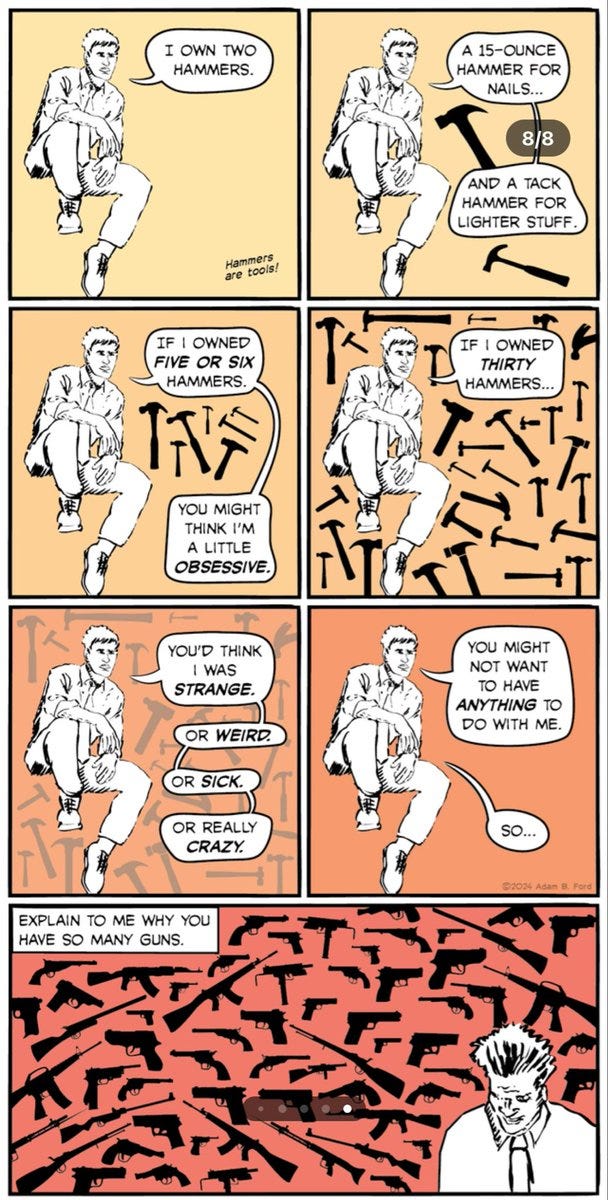

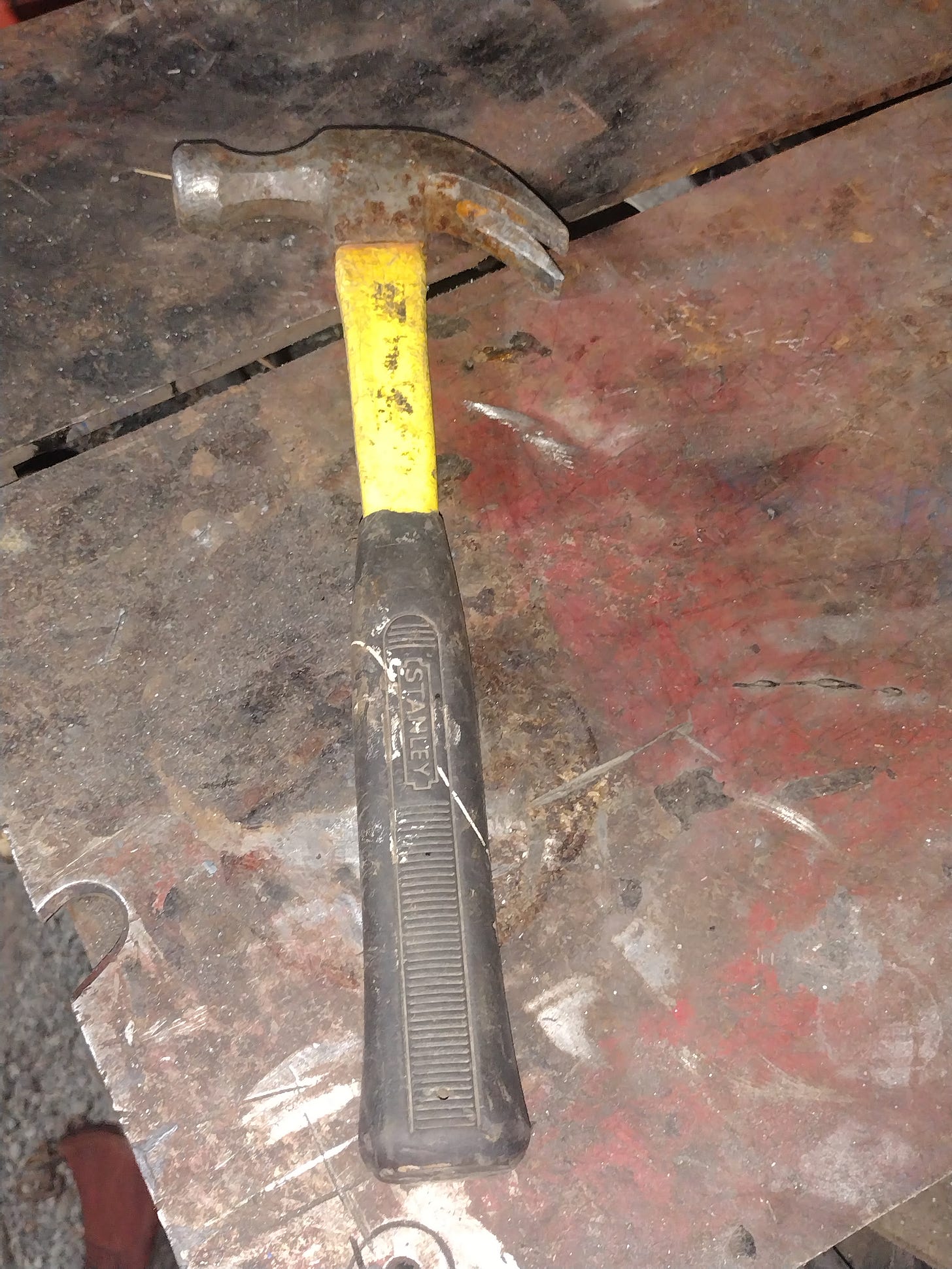

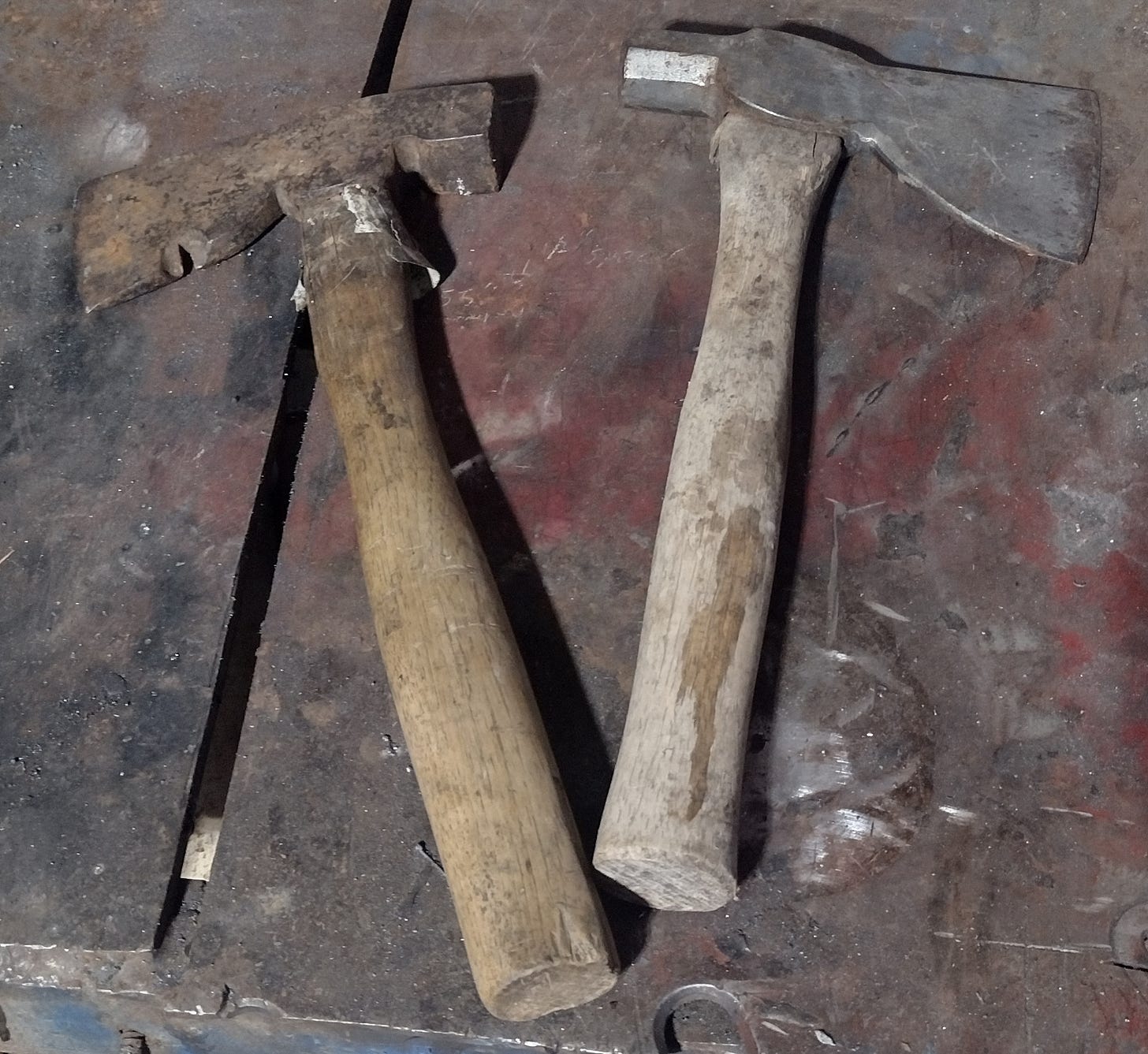


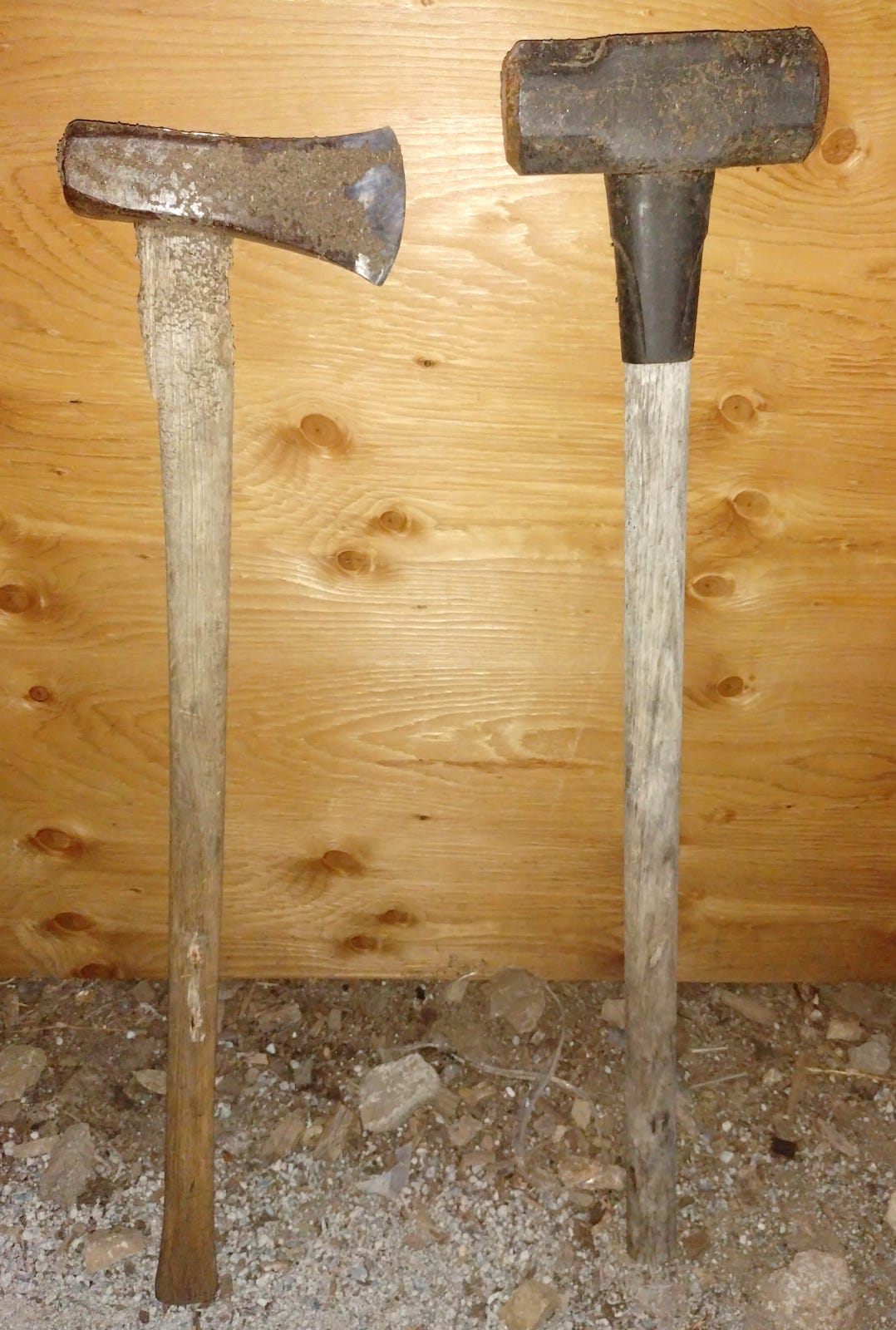

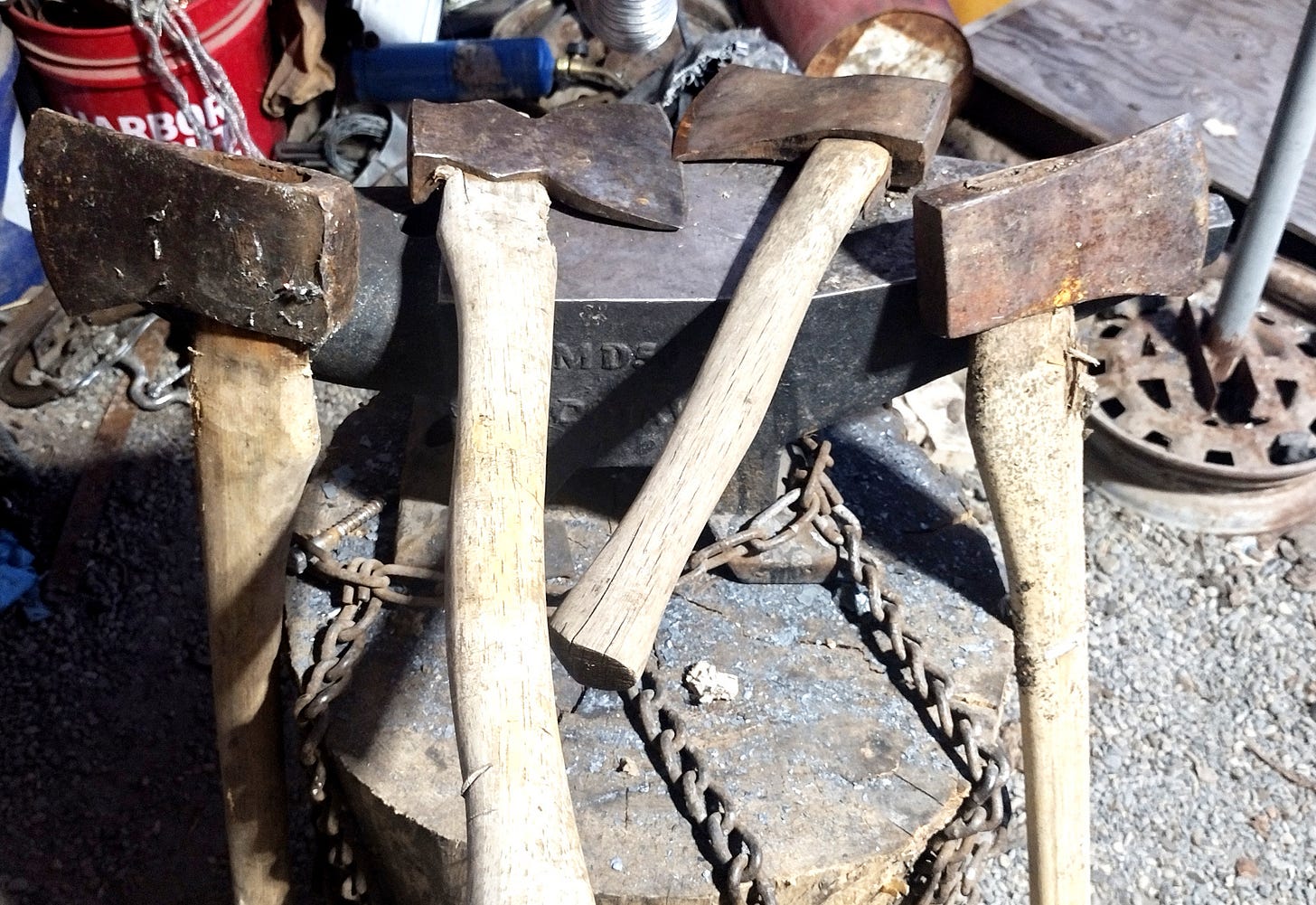


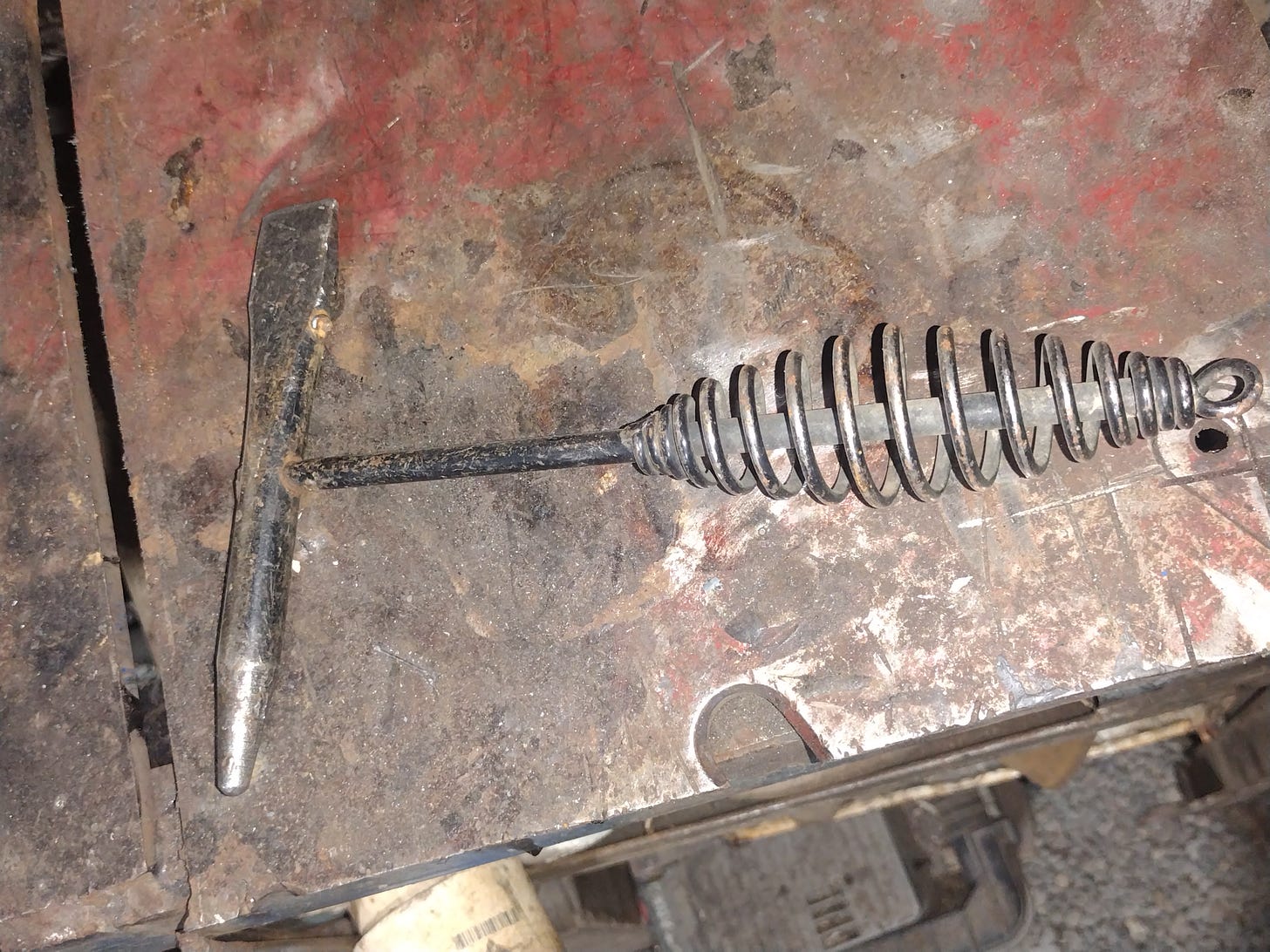


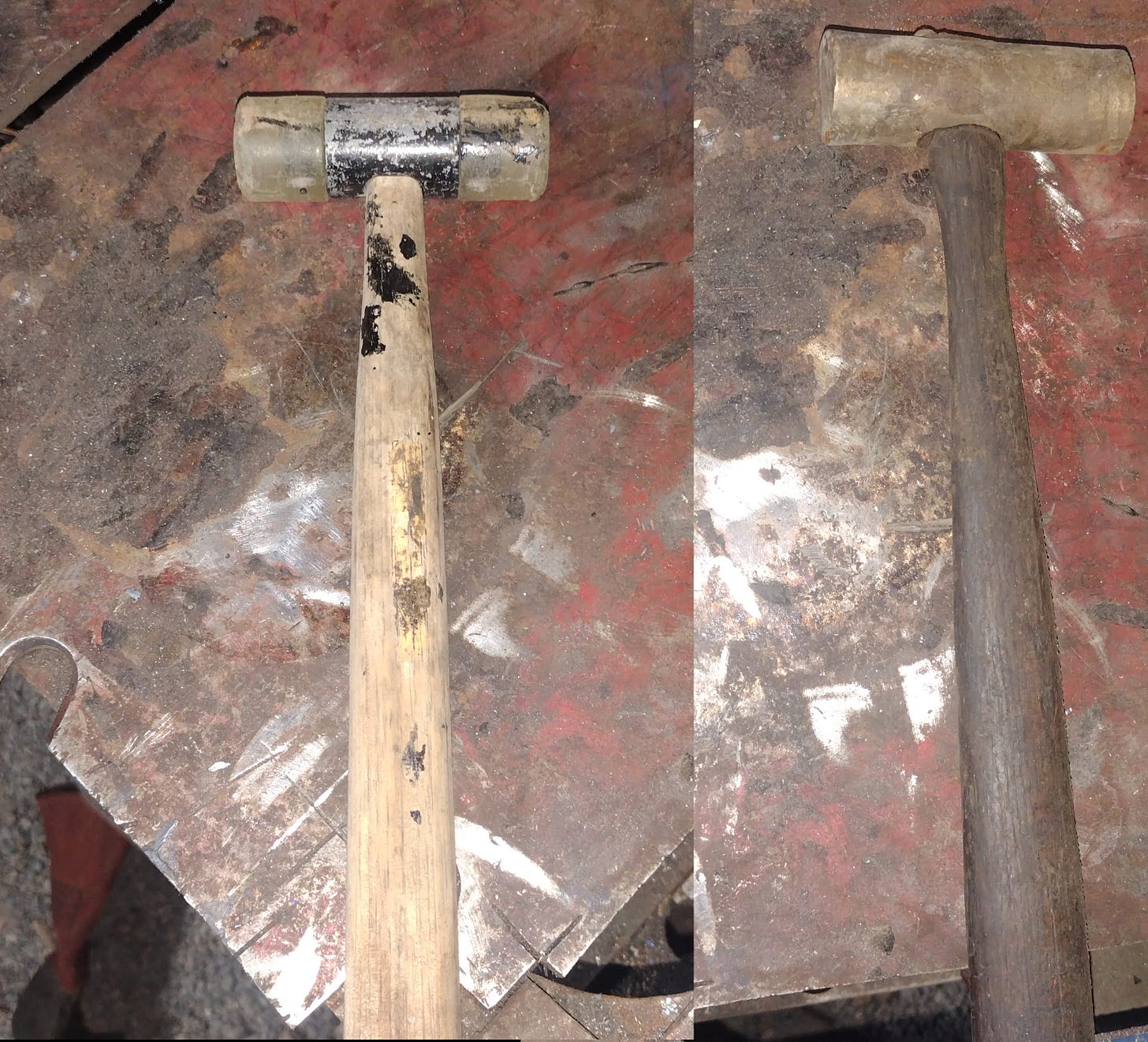
love this piece.
what do I love about it? well, ostensibly its about the various hammers you have, and their purpose. which is awesome. But that's not why I love the piece.
The thing that I love about it is how attached you are to your hammers.
or maybe, "why" are you so attached to them. You don't have attachment to them as "things."
Nope. Your attachment to them is the journey you've had with them. They are very personal to you.
The most beat up ones, and the ones you got from yard sales, are possibly even the best ones.
How you came about them, and what you have done *with* them, are the attachment.
I've got a large collection of tools for various purposes. They are like children to me. I love the ones that are the most used, the most f*ked up, the garage sale ones I got for nothing and put to work. They tell stories of some very personal experiences. They make me feel at home.
That's what I read in this work. I feel it. That was the whole point of this article.
They're alive.
I wonder if there are any statistics around the number of guns a person owns at the time one of those guns is used to kill someone (either by the owner or another house member). There may not be any correlation but I wouldn't be surprised if gun owners with a higher number of guns were less likely to be involved in a crime if, as you discuss, that implies they have an interest in guns as a hobby/craft/tool. Organized crime and gang affiliates excluded from the statistics as the bans or regulations people call for will not stop access to those groups.